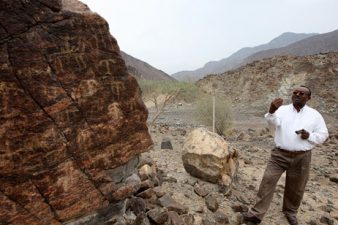 A list of women’s names written in cuneiform is the only remnant of this unidentified language, which was spoken 2,500 years ago.
A list of women’s names written in cuneiform is the only remnant of this unidentified language, which was spoken 2,500 years ago.
Found in the remains of an enormous palace that was destroyed by a fire around 700 BCE, the clay tablet pictured above holds the only remnants of a language previously unknown to modern scholars.
The language could contribute to our understanding of the ethnic groups who lived in the area thousands of years ago, and help map their interactions with the Assyrian Empire, according to Science Daily.
List of names holds key to language
On the banks of the Tigris River in southeastern Turkey are the magnificent ruins of Ziyaret Tepe, probable site of the ancient Assyrian frontier city of Tušhan. The site has been under excavation for the past 15 years, with special attention paid to the palace, which may have been built by the Assyrian King Ashurnasirpal II (883 — 859 BCE).
The tablet seems to be a list of all the women associated with the palace and the local Assyrian administration. Of 144 names on the table, just 59 are legible. One or two are Assyrian, a few are from other languages spoken in the Assyrian Empire, and 45 belong to the mysterious language.
The tablet was found by a team of researchers led by Timothy Matney, professor at the University of Akron, Ohio. It was deciphered by Dr John MacGinnis, from the McDonald Institute for Archaeological Research at Cambridge University, who described his findings in the April 2012 issue of the Journal of Near Eastern Studies.
MacGinnis’s analysis has determined that the names could not have come from other commonly spoken languages of the time, such as Urartian, Elamite, Egyptian, or West Semitic.
Who spoke the language?
There are several theories for where the language could have come from:
1) The language could have been Shubrian, the language indigenous to the area around Tušhan before the arrival of the Assyrians. However, Shubrian is believed to have been a dialect of the Hurrian language, which doesn’t resemble the names on the tablet.
2) The language could have belonged to the Mushki people, who were migrating into Eastern Anatolia at the time the tablet was made. However, historians haven’t found evidence that the Mushki had any interactions with the Assyrian Empire — and it seems unlikely that their names would have been recorded by Assyrian administrators if not.
3) The most convincing theory, according to MacGinnis, is that the language belonged to a people captured by the Assyrians and forcibly moved to Tušhan. In fact, of all the areas under Assyrian occupation, historians are only missing the language of one: the Zagros Mountains in Iran.
“If correct this suggests that Iran was home to previously unknown languages,” wrote MacGinnis in his article.
Read more about archaeology in the Middle East:
Man Evolved When Elephant Meat Ran Out
Ancient Paw Print Found Near Roman Bath In Jerusalem
This UNESCO Bioreserve Is Refuge For Prophets, People and Wildlife
Image via John MacGinnis



